Where Are Smart Objects Saved Photoshop
Adobe Photoshop doesn't plow layers into smart objects by default, so it tin can be easy to forget how useful they are. But they have some amazing benefits that y'all should know about – most of all, the ability to re-edit filters that you've applied to a layer.
That's not the only reason to convert a layer to a smart object, but it's i of the biggest. 2 others reasons that are important in photography are that smart objects make it easier to exercise image averaging and perform nondestructive transform/warps of layers. They are as well helpful in graphic design for various purposes.
Tabular array of Contents
What Is a Smart Object?
A smart object is the ultimate non-destructive layer in Photoshop. Any edits that yous apply to a smart object can be undone or revisited; they're never broiled permanently into the layer.
Allow me demonstrate how a smart object differs from an ordinary layer. If you utilise Photoshop's transform tool to shrink an ordinary layer, it will turn into a low resolution version of itself. Trying to enlarge it back to the original size will requite you a blurry epitome:
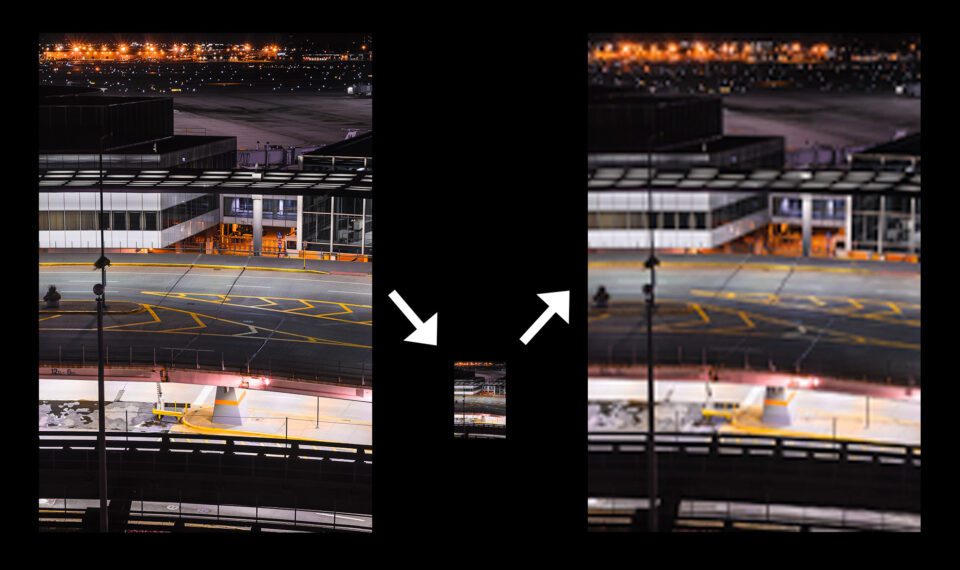
If y'all practise the same process to a layer that has been converted to a smart object, you can shrink and resize the layer to your eye'southward content, and it remains just every bit sharp:
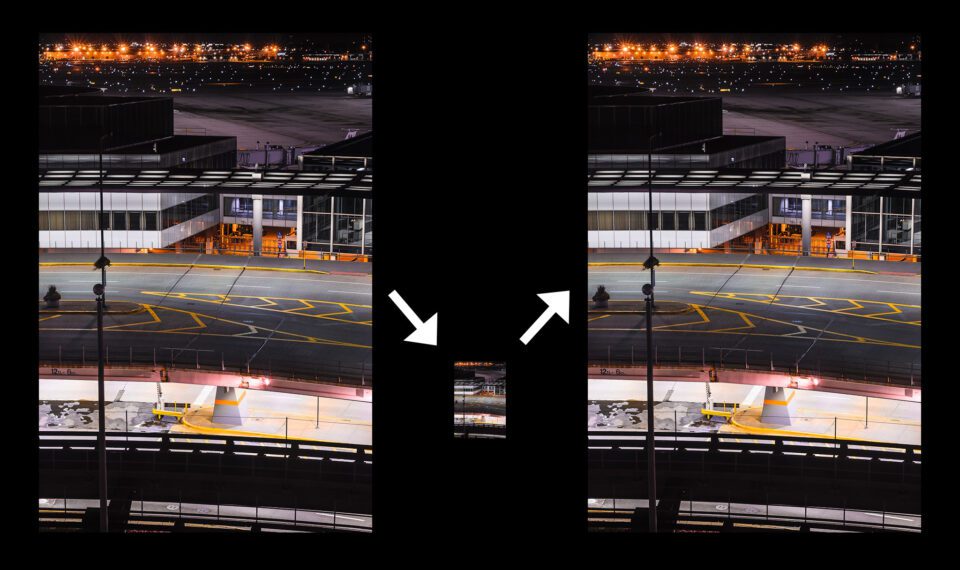
The nondestructive character of smart objects goes beyond just resizing layers, equally I'll testify in a moment. First, though, let's look at the different ways to make a smart object.
How to Create Smart Objects in Photoshop
Converting a layer to a smart object is very easy in Photoshop. You only right click on the layer in question and select "Convert to Smart Object."
Y'all can also create a smart object out of multiple layers. Shift + click (or Ctrl/Cmd + click) to select the layers you want, right click, and select "Catechumen to Smart Object." The layers will merge into a unmarried smart object layer. Photoshop then lets you lot cull how the component layers within the smart object blend together; but go to Photoshop's peak bill of fare > Layer > Smart Objects > Stack Way, and you lot'll see a number of options.
Yous can as well convert a layer to a smart object direct from Adobe Photographic camera Raw, which I highly recommend. After you lot've opened a raw file in Adobe Camera Raw and finished your edits, just hold down the Shift key, and you lot'll encounter that the "Open up" push at the lesser of Camera Raw changes to "Open Object." Click it, and the photograph you've been editing will open up directly as a smart object for further editing in Photoshop.
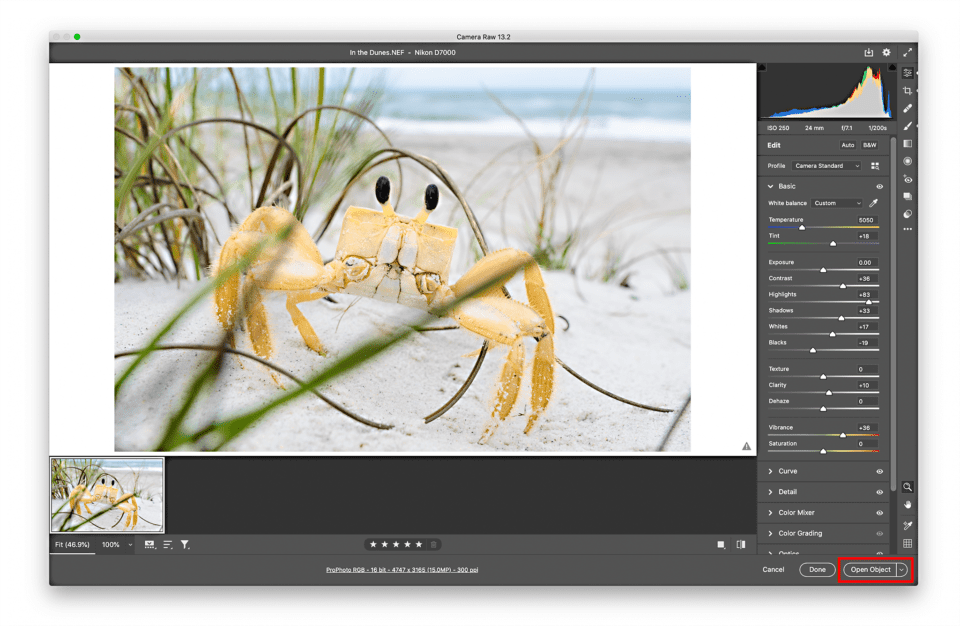
Benefits of Smart Objects for Photographers
In that location are tons of reasons to utilise smart objects in Photoshop, and I'm going to limit this article to the three that I consider the most useful for photography. (You can encounter a longer list of what they do, including some niche uses, on Adobe's website.) Here are the ones that are the most important for photographers to know:
1. Nondestructive Filters
Photoshop's filter tools are a huge assistance for photography, especially at present that the Camera Raw dialog has been added as a filter selection in the newer versions of Photoshop. I routinely use the Camera Raw filter to make global adjustments in Photoshop, and I'll also utilize filters similar sharpening, noise reduction, and Gaussian blur on occasion.
But what happens if y'all apply a filter and merely realize afterwards that you went a chip also far? You might have to delete the layer and offset over, which can exist a serious problem if you've done a number of other edits to that layer in the meantime.
Instead, if you catechumen a layer to a smart object before applying any filters, they become "smart filters" instead. A list of all your smart filters appears under the smart object in Photoshop, and you can double click any of their names to re-open the filter dialog.
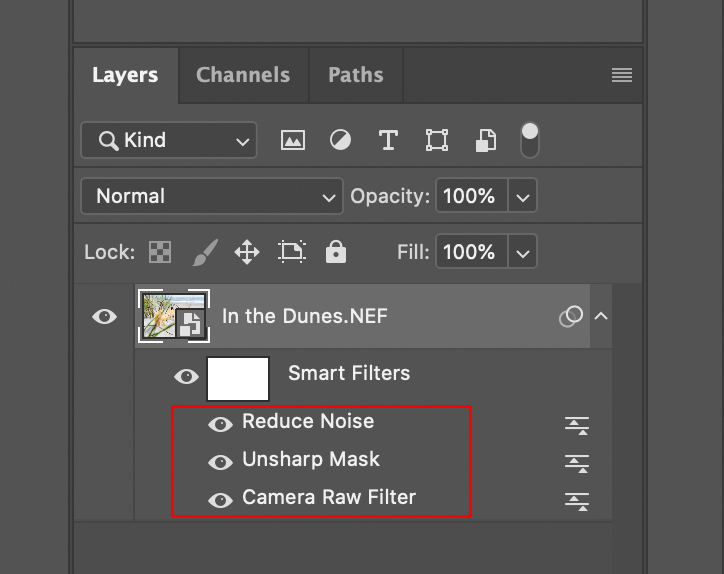
This tin can be a huge assistance for photographers. Did you lot realize as well tardily that your before unsharp mask was as well stiff? Double click the words "Unsharp Mask" below your smart object, and you can tone down your prior edits. Missed a spot in a Camera Raw local adjustment? No need to delete the layer and start over; it'south all stored in the smart object and tin exist re-edited at whatsoever time by double clicking the title "Camera Raw Filter." (This is why I recommend "opening as object" rather than simply opening your image any time you finish working with a raw file in Adobe Camera Raw.)
You can fifty-fifty blend the smart filters using layer blend modes by double clicking the icon on the correct-hand border of whatsoever smart filter:
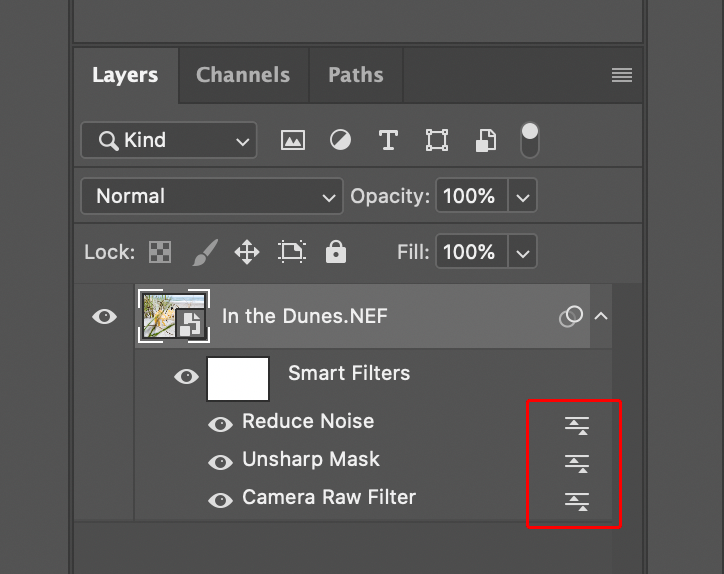
Doing and so will pop up a dialog that looks like this, assuasive you to modify the opacity and blend manner just like any other layer:
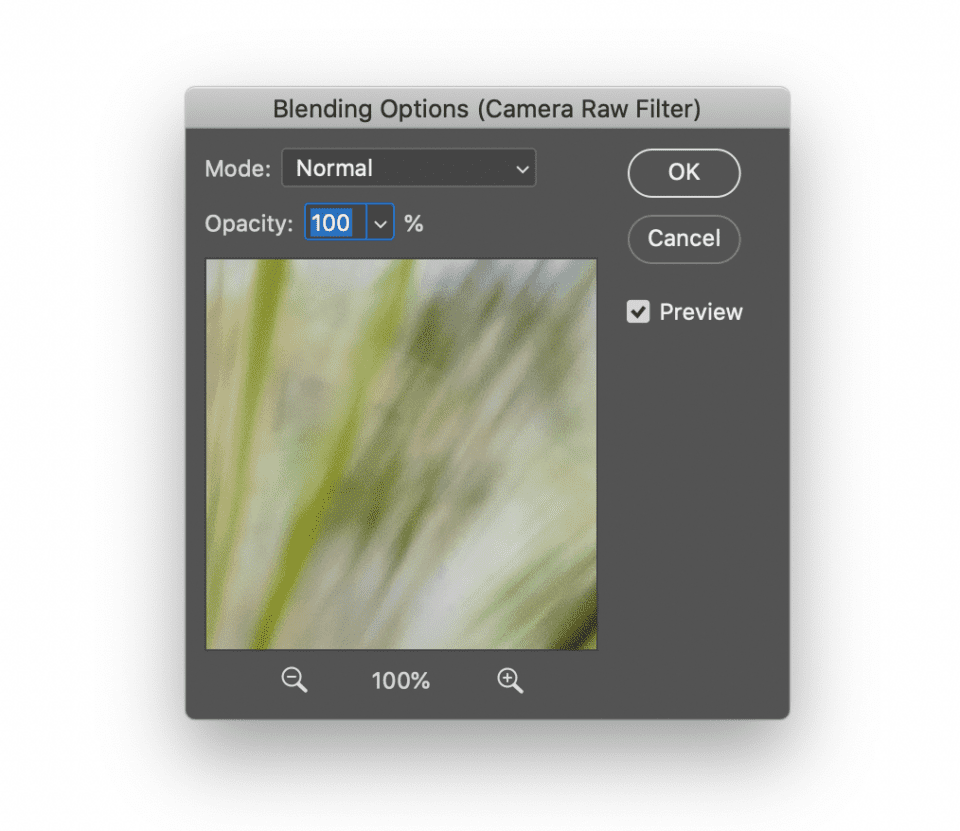
Overall, being able to re-practice any filter edits is the biggest reason to convert a layer to a smart object in Photoshop, at least for photography. Once you start using it, yous'll never look back.
2. Nondestructive Transform
Another helpful reason to use smart objects is to warp or transform the layer without permanently baking the transformation into the layer. I demonstrated this before in the article, and hopefully you tin can come across how it would exist useful to have such an choice for resizing different layers.
Still, this simply really applies if you lot're doing some sort of blended photography, whether surrealistic or something more grounded like product photography. Not all photographers demand to blended images together, but if you lot exercise, it's best to convert your layers to smart objects earlier resizing them.
For example, if you were editing this blended paradigm (taken past Nasim), yous should commencement past converting each of the 3 moon layers to a smart object so as not to lose resolution when decreasing and increasing their size:
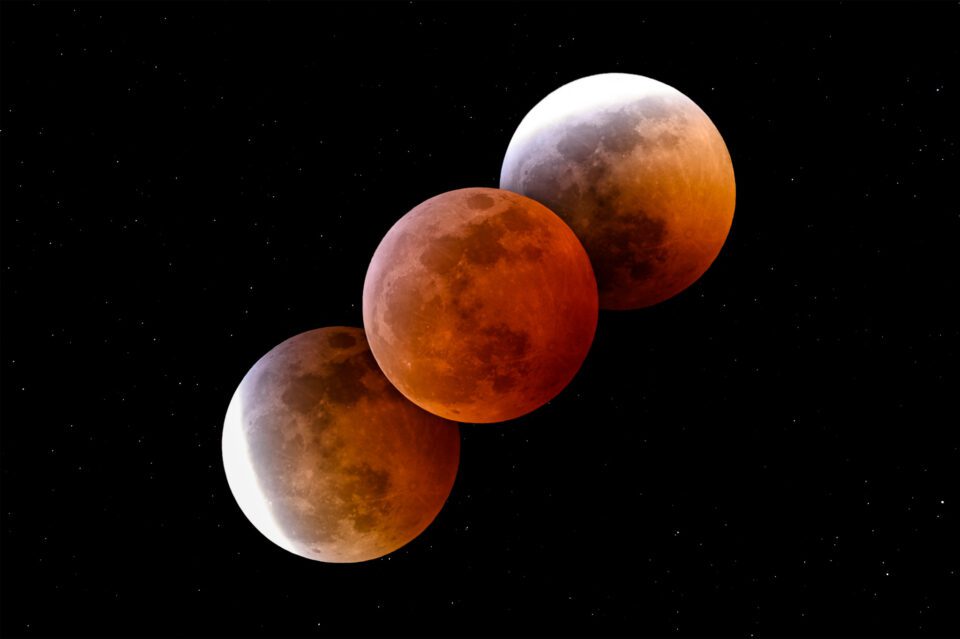
NIKON Z7 + 300mm f/4 @ 420mm, ISO 200, 10 seconds, f/eight.0
three. Image Averaging to Reduce Noise
The technique of epitome averaging has really been growing on me lately, especially for applications like drone photography. By taking multiple identical photos and and then averaging them together in Photoshop, the full level of noise will driblet essentially:
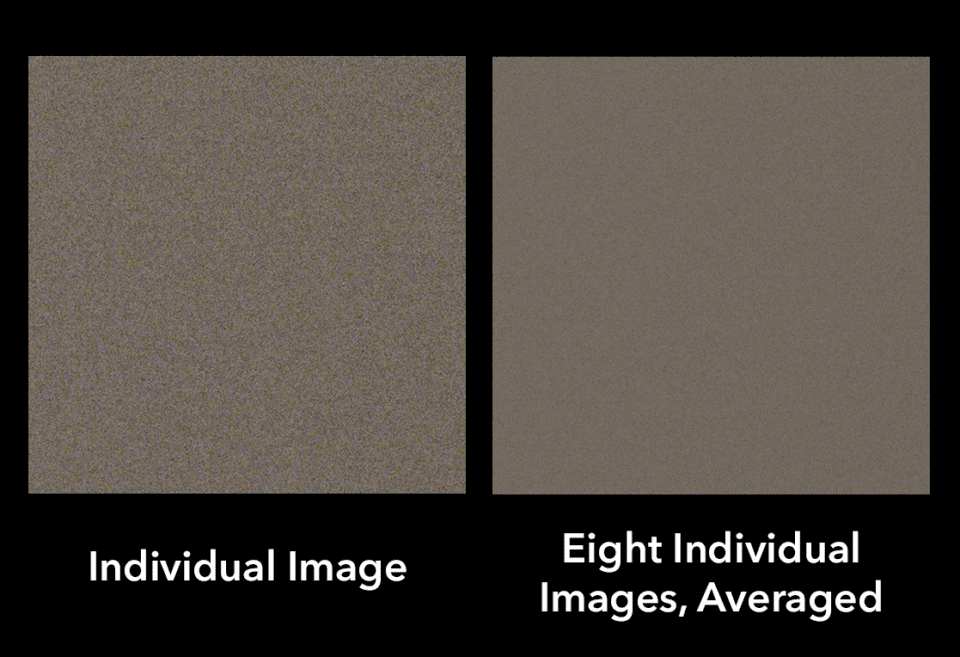
Simply how do yous actually average a bunch of layers together in Photoshop? Yous could play around with the Opacity slider, but the easier manner in many cases is to use a smart object.
Beginning, select all the layers that you want to average by Shift + clicking. Right click to catechumen them to a single smart object. So, get to Photoshop's top carte bar > Layer > Smart Objects > Stack Way > Mean. (Some photographers prefer Median instead of Mean, but I detect that Mean works better.)
The layers will be averaged together perfectly, whether you have two layers or several dozen. (Though the stacking procedure is far from quick if you have more than a handful of layers, and then yous might want to accept a stretch pause while yous expect.)
At that place are more reasons to do image averaging than just reducing noise, including various graphic design applications. You can also experiment with unlike stack modes than Hateful to get some interesting results. Regardless, smart objects are the way to practice it.
Drawbacks of Smart Objects
The biggest consequence with smart objects is that they take up more space than ordinary layers. Yous may notice Photoshop slow down if y'all take as well many smart objects (or a lot of smart filters). It will too brand your file sizes much larger if yous're saving a file with layers, such as a PSD or PSB.
Notwithstanding, if you lot consign as a JPEG or otherwise flatten the smart object layers, the file size consequence goes away. In other words, these drawbacks only employ when there are active smart object layers in your document.
Beyond that, you should continue in mind that some edits are not possible on smart object layers, such as using the brush tool, pigment bucket tool, dodge, burn, blur/sharpen/smudge tools, and similar. These aren't possible because, again, a smart object is the ultimate nondestructive layer. Photoshop doesn't have a manner to revisit these sorts of "paint on the moving picture" edits, then it only prevents you from doing them on a smart object in the first identify.
If you lot've decided to do i of these edits anyhow, you merely need to rasterize the layer first. Rasterizing a layer turns it from a smart object to a regular layer, allowing y'all to brand those edits. Just correct click on the layer and select "Rasterize Layer." Y'all tin too rasterize a layer by attempting to practise your edit (say, trying to paint on the layer) and selecting "OK" to rasterize the smart object when Photoshop yells at you.
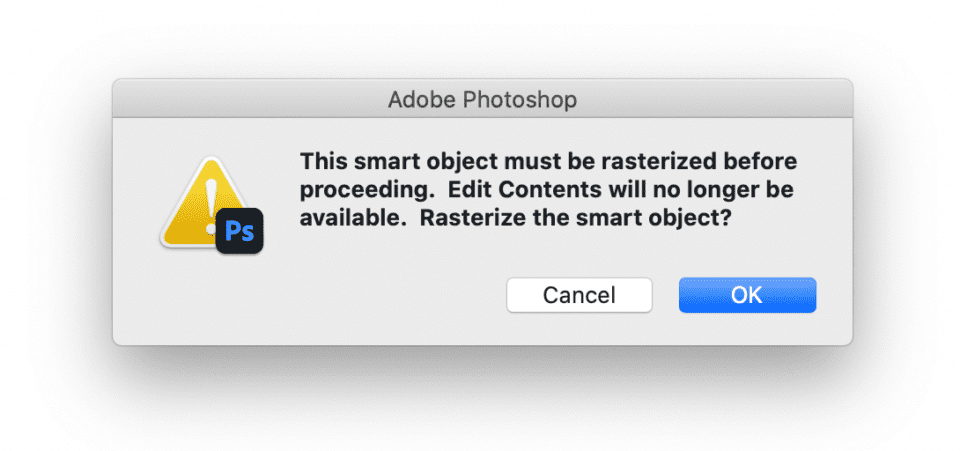
Conclusion
Information technology'due south not ever necessary to convert a layer to a smart object, which is why Photoshop doesn't do information technology past default. If yous don't need to apply filters, average layers, or perform warp/transform adjustments, it'south probably all-time to go on the layers every bit they are. By minimizing the number of smart objects, you can shrink the size of your PSD files and speed up Photoshop.
Notwithstanding, smart objects are critical when you're working with filters, which of course are some of the most popular tools in Photoshop. Filters come up into play almost any time y'all want to sharpen an image, apply an Orton event, or simply make wide adjustments in Adobe's Camera Raw dialog. In those cases, it's normally non ideal to broil the filter into the layer; instead, just convert the layer to a smart object alee of time so that you tin revisit the filter later and adapt it to your liking.
I hope this commodity helped y'all understand why smart objects are so useful for photography. They're also useful for graphic blueprint work; I apply them constantly when making the diverse charts and illustrations you lot encounter on Photography Life. In fact, no matter what field of digital art y'all're working with, nondestructive editing is critical – and smart objects are an of import part of nondestructive editing when you're working in Photoshop.
Source: https://photographylife.com/photoshop-smart-objects-explained
Posted by: dunnareacking.blogspot.com

0 Response to "Where Are Smart Objects Saved Photoshop"
Post a Comment